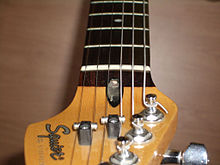Truss rod
A truss rod is a guitar part used to stabilize and adjust the profile (also called the relief), of the neck. Usually it is a steel rod that runs inside the neck and has a bolt that can be used to adjust its tension. The first truss rod patent was applied for by Tim McHugh, an employee of the Gibson company, in 1921.
Application

When the truss rod is loosened (i.e. moved towards the guitar's body), it allows the neck to bend slightly in response to the tension of the strings. Similarly, when tightened (i.e. moved towards the guitar's headstock) the truss rod straightens the neck by resisting the tension of the strings. As guitar strings vibrate in an elliptical pattern, it is usually desirable for a guitar neck to have a slight curvature, to allow each string to vibrate along its full length.
Truss rods are required for instruments with steel (high tension) strings. Without a truss rod, the guitar's wooden neck would gradually warp (i.e. bend) beyond repair due to applied high tension. Such devices are not normally needed on instruments with lower tension strings, such as the classical guitar which uses nylon (previously catgut) strings.
Construction and action
Truss rods are frequently made out of steel, though graphite and other materials are sometimes used.
The truss rod can be adjusted to compensate for expansion or contraction in the neck wood due to changes in humidity or temperature, or to compensate for changes in the tension of the strings (the thicker the guitar string, the higher its tension when tuned to concert pitch).
Usually, the truss rod of a brand-new instrument is adjusted by the manufacturer before sale. Adjusting the truss rod is not recommended for a novice, as guitar necks can be easily damaged beyond repair in the process. Luthiers or more experienced players can adjust it when necessary (e.g. if strings of a very different tension are to be used). Turning the truss rod clockwise will tighten it, counteracting the tension of the strings and straightening the neck or creating a backward bow. Turning the truss rod counter-clockwise will loosen it, allowing string tension to act on the neck and creating a forward bow (higher string action).
Some guitars (Notably Rickenbackers) come with dual truss rods that are more stable and not affected by seasonal climate changes, they are also more difficult to adjust and should be serviced by a professional. Though uncommon there are also left-handed truss rods that need to be rotated in the opposite direction of a normal truss rod.
Location and adjustment

The truss rod tension is usually controlled using an adjustment bolt (a hex nut or allen-key). Depending on the model of guitar, this bolt can be located:
- On older Fender-style electric guitars with bolt-on necks (and vintage re-issues) — on the heel of the neck. Adjustment of such truss rods can be done by a Phillips screwdriver and requires prior removal of the guitar's pickguard or neck.
- On newer Fender-style electric guitars — behind the nut, uncovered and can usually be adjusted by a 1/8" (3 mm) Allen wrench.
- On set-neck electrics — under a cover-plate behind the nut. Gibson & Epiphone guitars have their truss rod bolt covered with a signature bell-shaped plate. Most Gibson electrics have a 5/16” (8 mm) or a 1/4" (6 mm) hex adjustable truss rod nut that can be adjusted with a hex box spanner wrench.
- On acoustic guitars — inside the guitar body, accessible through the sound hole, or on the headstock. Martin's use a 3/16" (5 mm) Allen wrench and Gibson uses the same as for the Gibson electrics above.
- Counterclockwise adjustment will decrease the truss rod tension (correct an overbow) and clockwise adjustment will increase the truss rod tension (correct an underbow).
See also
External links
- Wiki Guitar Wiki-based guitar resource.
